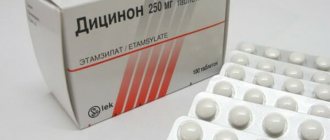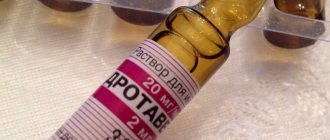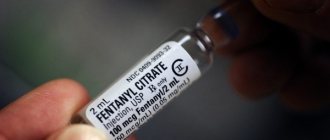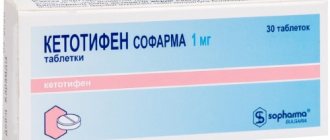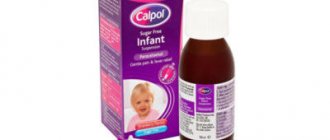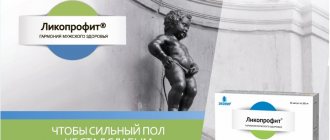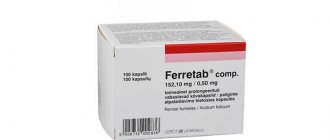Release form and composition
Dicynon is available in tablets and in the form of an injection solution.
The active substance of the drug is etamsylate. Its concentration in one tablet is 250 mg, in 1 ml of solution – 125 mg.
The auxiliary components in Dicinon tablets include anhydrous citric acid, corn starch, magnesium stearate, povidone K25, lactose.
In addition to ethamsylate, the solution contains sodium disulfite, water for injection, and sodium bicarbonate (in some cases necessary to correct the pH level).
The tablets are supplied to pharmacies packaged in blisters of 10 pieces, sold in 10 blisters in cardboard packaging. The solution for intramuscular and intravenous administration is sold in 2 ml colorless glass ampoules, 10 ampoules in a blister, 5 blisters in a cardboard box.
Reviews
Before taking this medicine, it is important to understand not only the instructions for Dicynon ampoules and analogues; reviews from patients and doctors are no less important.
It demonstrates high effectiveness when it is necessary to stop bleeding urgently or systemically. For example, it is prescribed to inject it intramuscularly for hemoptysis, as well as during operations.
Having studied the instructions for Dicynon ampoules and reviews, we can come to the conclusion that this is actually an effective remedy that can help even in difficult cases.
Indications for use
The use of Dicinon is indicated for the treatment and prevention of capillary bleeding of various origins.
According to the instructions, etamsylate is effective for:
- Bleeding that occurs during and after surgical interventions on all well-vascularized (permeated with blood vessels) tissues in obstetrics and gynecology, ENT practice, dentistry, plastic surgery, urology, ophthalmology;
- Menorrhagia, including primary, as well as in women with intrauterine contraceptives;
- Bleeding gums;
- Hematuria;
- Nosebleeds;
- Metrorrhagia;
- Diabetic microangiopathy, including hemophthalmos, hemorrhagic diabetic retinopathy, etc.;
- Hemorrhagic cerebrovascular accidents in newborns, including premature babies.
Analogs
In the instructions for the Dicynone ampoule, the analogue that is most often used when this drug is unavailable or impossible to use is “Etamsylate” and its derivatives.
"Etamzilat" is an antihemorrhagic agent that actively improves microcirculation and normalizes the permeability of the vascular wall. Its action is associated with a significant effect on the formation of thromboplastin. However, it does not affect prothrombin time, does not contribute to the formation of blood clots and does not have hypercoagulable properties. In this regard, it is often much preferable to many other similar drugs.
Once the drug enters the body, it begins to act in approximately five to fifteen minutes if an intravenous injection was given. The maximum effect can be achieved after one to two hours. The total duration of action is four to six hours.
This drug is used in the treatment and prevention of capillary bleeding that occurs in diabetic angiopathy. Also for surgical interventions in ophthalmology, otolaryngology practice, urology, dentistry, gynecology and surgery.
Its use is widespread in emergency cases of hemorrhagic diathesis and pulmonary hemorrhage.
It is prohibited to use this drug in case of thromboembolism, thrombosis, or hypersensitivity to etamsylate itself. Side effects include the following negative conditions:
- headache;
- heartburn;
- dizziness;
- feeling of heaviness in the epigastric region;
- facial hyperemia;
- paresthesia of the lower extremities;
- decrease in systolic blood pressure.
During pregnancy, its use is allowed only if the predicted effect of treatment exceeds the potential risk to the newborn. During lactation, breastfeeding should be stopped immediately. As you can see, in many respects this drug is similar to Dicynon; they have approximately the same side effects and contraindications.
Contraindications
In accordance with the instructions for Dicinon, the use of the drug is contraindicated if the patient has:
- Neoplastic (tumor) diseases of lymphatic and hematopoietic tissues, including osteosarcoma, myeloblastic and lymphoblastic leukemia;
- Thrombosis;
- Acute porphyria;
- Thromboembolism;
- Hypersensitivity to the components of the tablets/solution.
Dicinon is used with caution to treat patients with a history of thrombosis or thromboembolism, as well as in cases where the cause of bleeding is an overdose of anticoagulants.
Dicinone in ampoules: side effects and complications
Before starting therapy with Dicynon, you should pay attention to the fact that the medication can cause side effects. Often, rashes and hyperemia may appear on the skin, and headaches and dizziness may appear on the nervous system. Problems with the digestive system may occur:
- heartburn;
- nausea;
- vomit;
- heaviness;
- pain syndromes.
In addition, Dicynon has a serious effect on the cardiovascular, lymphatic and circulatory systems. The effect is manifested in a decrease in blood pressure, the occurrence of thromboembolism, thrombocytopenia, neutropenia, and agranulocytosis.
Effects on the immune system are very rare. But it can manifest itself in the form of allergic reactions, itching, swelling and redness.
Side effects may include fever and asthenia. Also, sometimes redness and itching appear at the injection site.
Directions for use and dosage
The optimal daily dose of Dicinone in tablet form for an adult is from 10 to 20 mg per 1 kg of body weight. Divide it into 3 or 4 doses.
As a rule, the average single dosage is 250-500 mg, in exceptional cases it is increased to 750 mg. The frequency of use of Dicinon is the same, 3-4 times a day.
For menorrhagia, the daily dose of etamsylate is from 750 mg to 1 g. Dicinone should be taken from the 5th day of the expected menstruation until the 5th day of the next cycle.
After surgical interventions, it is recommended to take the drug every 6 hours, 250-500 mg. The pills are continued as long as the risk of bleeding continues.
For a child, a single dose is 10-15 mg per 1 kg of body weight. Frequency of applications – 3-4 times a day.
The instructions for Dicinon indicate that the injection solution is intended for slow intravenous or intramuscular injections. In cases where the product is diluted with saline, the injection should be done immediately.
For an adult, the daily dose is 10-20 mg/kg/day, divided into 3-4 administrations.
For preventive purposes during surgical interventions, Dicynone is administered intravenously or intramuscularly at a dose of 250-500 mg approximately one hour before surgery. During surgery, the drug is administered intravenously in a similar dose; if necessary, this dose is repeated again. In the postoperative period, it is recommended to use Dicinon in the initial dosage every 6 hours until the risk of bleeding disappears.
For children, the solution is prescribed at a dose of 10-15 mg/kg/day, divided into 3-4 injections. In neonatological practice, Dicynone is administered into a muscle or very slowly into a vein at a dose of 12.5 mg/kg (the indicated dose of etamsylate corresponds to 0.1 ml of solution). Treatment begins in the first two hours of the child's life.
Composition of the drug Dicinon, its effect on the body
The action of the drug is based on the ability of ethamsylate to create thromboplastin. Dicinone in ampoules is used, according to the instructions for use, for bleeding and hemorrhage.
This is what genuine dicinone looks like in ampoules. Instructions for use must be included in the package
In addition to the main ingredient, the medication contains water, sodium disulfite and bicarbonate. The solution is colorless and transparent.
The drug promotes the formation of mucopolysaccharides, which protect protein fibers from damage and normalize capillary permeability. Dicynone removes excess fluid located in the bloodstream of the vessel, increases the strength of capillaries, provokes the creation of platelets in the hematopoietic bone marrow, prolongs their existence and enhances activity.
The advantage of Dicinon is that it does not constrict blood vessels, does not increase coagulation and does not provoke the formation of blood clots.
After 15 minutes after injection into the vein, the effect of the medicine appears. The peak effect is noticeable an hour after the injection. The total duration of action lasts no more than 6 hours.
In a situation where the medication is injected into the muscle, the effect becomes noticeable four hours after the injection.
Dicinone is perfectly absorbed in the body and is equally distributed throughout the organs and tissues. Practically does not react with proteins and enzymes contained in the blood. The medication is quickly eliminated from the body with urine and bile.
special instructions
Dicynon injection solution is intended exclusively for use in clinics and hospital inpatient settings.
It is prohibited to mix the solution in one syringe with any other medicine. It is contraindicated to use the solution if it has changed color.
It should be borne in mind that Dicinone at a dose of 10 mg/kg, administered one hour before dextrans, prevents their antiplatelet effect. And Dicynone, administered after dextrans, does not have a hemostatic effect.
Dicynone is incompatible with sodium lactate and sodium bicarbonate solutions for injection. If necessary, it can be combined with menadione sodium bisulfite and aminocaproic acid.
One tablet of Dicynon contains 60.5 mg of lactose (the permissible highest dose of this substance is 5 grams). Tablets are contraindicated in patients with lactase deficiency, congenital glucose intolerance, impaired absorption of glucose and galactose.
Although Dicynon solution is intended for intramuscular and intravenous administration, it can be used topically, for example, after tooth extraction or in the presence of another wound. To do this, a piece of gauze or a sterile swab is generously soaked in the solution and applied to the injury.
Use of Dicinon during pregnancy and lactation
You should avoid injections during pregnancy. Use may only be prescribed if the intended benefit to the mother outweighs the risks to the embryo.
During pregnancy, the medication is used to combat brown and spotting discharge, detachment of the placenta and the outer membrane of the embryo.
In a situation where the use of the medication is prescribed during breastfeeding, the administration of Dicynon is possible, but subject to cessation of lactation. This is due to the fact that the drug substance, passing through all barriers, enters breast milk, and with it into the baby’s body.


